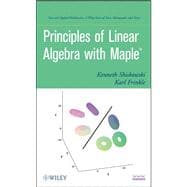
What is included with this book?
Kenneth Shiskowski, PhD, is Professor of Mathematics at Eastern Michigan University. His areas of research interest include numerical analysis, the history of mathematics, the integration of technology into mathematics, differential geometry, and dynamical systems.
Karl H. Frinkle, PhD, is Associate Professor of Mathematics at Southeastern Oklahoma State University. He has extensive academic experience teaching in the areas of algebra, trigonometry, and calculus. Dr. Frinkle currently focuses his research on Bose-Einstein condensates, nonlinear optics, dynamical systems, and the integration of technology into mathematics.
| Preface | |
| Conventions and Notations | |
| An Introduction To Maple | |
| The Commands | |
| Programming | |
| Linear Systems of Equations and Matrices | |
| Linear Systems of Equations | |
| Augmented Matrix of a Linear System and Row Operations | |
| Some Matrix Arithmetic | |
| Gauss-Jordan Elimination and Reduced Row Echelon Form | |
| Gauss-Jordan Elimination and rref | |
| Elementary Matrices | |
| Sensitivity of Solutions to Error in the Linear System | |
| Applications of Linear Systems and Matrices | |
| Applications of Linear Systems to Geometry | |
| Applications of Linear Systems to Curve Fitting | |
| Applications of Linear Systems to Economics | |
| Applications of Matrix Multiplication to Geometry | |
| An Application of Matrix Multiplication to Economics | |
| Determinants, Inverses and Cramer's Rule | |
| Determinants and Inverses from the Adjoint Formula | |
| Determinants by Expanding Along Any Row or Column | |
| Determinants Found by Triangularizing Matrices | |
| LU Factorization | |
| Inverses from rref | |
| Cramer's Rule | |
| Basic Linear Algebra Topics | |
| Vectors | |
| Dot Product | |
| Cross Product | |
| Vector Projection | |
| A Few Advanced Linear Algebra Topics | |
| Rotations in Space | |
| 'Rolling' a Circle Along a Curve | |
| The TNB Frame | |
| Independence, Basis and Dimension for Subspaces of Rn | |
| Subspaces of Rn | |
| Independent and Dependent Sets of Vectors in Rn | |
| Basis and Dimension for Subspaces of Rn | |
| Vector Projection onto a Subspace of Rn | |
| The Gram-Schmidt Orthonormalization Process | |
| Linear Maps from Rn to Rm | |
| Basics About Linear Maps | |
| The Kernel and Image Subspaces of a Linear Map | |
| Composites of Two Linear maps and Inverses | |
| Change of Bases for the Matrix Representation of a Linear Map | |
| The Geometry of Linear and Affine Maps | |
| The Effect of a Linear Map on Area and Arclength in Two Dimensions | |
| The Decomposition of Linear Maps into Rotations, Reflections and Rescalings in R2 | |
| The Effect of Linear Maps on Volume, Area and Arclength in R3 | |
| Rotations, Reflections and Rescalings in Three Dimensions | |
| Affine Maps | |
| Least Squares Fits and Pseudoinverses | |
| Pseudoinverse to a Non-Square Matrix and Almost Solving an Overdetermined Linear System | |
| Fits and Pseudoinverses | |
| Least Squares Fits and Pseudoinverses | |
| Eigenvalues and Eigenvectors | |
| What Are Eigenvalues and Eigenvectors, and Why Do We Need Them? | |
| Summary of Definitions and Methods for Computing Eigenvalues and Eigenvectors as well as the Exponential of a Matrix | |
| Applications of the Diagonalizability of Square Matrices | |
| Solving a Square First Order Linear | |
| System of Differential Equations . . . . . . . . . . . . . . . . | |
| Basic Facts About Eigenvalues and Eigenvectors, and Diagonalizability | |
| The Geometry of the Ellipse Using Eigenvalues and Eigenvectors | |
| A Maple Eigen-Procedure | |
| Bibliography | |
| Indices | |
| Keyword Index | |
| Index of Maple Commands and Packages | |
| Table of Contents provided by Publisher. All Rights Reserved. |
The New copy of this book will include any supplemental materials advertised. Please check the title of the book to determine if it should include any access cards, study guides, lab manuals, CDs, etc.
The Used, Rental and eBook copies of this book are not guaranteed to include any supplemental materials. Typically, only the book itself is included. This is true even if the title states it includes any access cards, study guides, lab manuals, CDs, etc.